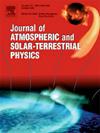北向IMF期间赤道上空由IMF驱动的电场扰动:PPEF响应
IF 1.9
4区 地球科学
Q3 GEOCHEMISTRY & GEOPHYSICS
Journal of Atmospheric and Solar-Terrestrial Physics
Pub Date : 2025-09-17
DOI:10.1016/j.jastp.2025.106642
引用次数: 0
摘要
本文首次提供了由行星际磁场(IMF)准周期变化驱动的赤道和低纬度电离层电场扰动的证据。通过分量,在恒定的北行星际磁场Bz (~ +15 nT)、太阳风动压(~ 8 nPa)、太阳风速度(~ 450 km/s)和正symm - h (+10 nT)下。在美洲(Jicamarca, 11.9°S,−76.0°E; Fortaleza, 3.9°S,−38.52°E)和印度(Trivandrum, 8.5°N, 77.0°E; Tirunelveli, 8.73°N, 77.7°E)扇区,由电离层仪在相反经度测量的F层虚拟高度(h 'F)显示,在IMF变化的驱动下,白夜间的电场扰动具有相反的极性。在向北的IMF Bz条件下,Jicamarca非相干散射雷达(ISR)测量的垂直E × B等离子体漂移,以及赤道电喷流(EEJ)观测显示,白天侧的西向电场干扰。相反,在夜晚,Trivandrum和Tirunelveli的电离探空仪测量显示向东的电场扰动。值得注意的是,在两个当地时间扇区的IMF By和电离层参数(如dh'F/dt和EEJ)中都观察到具有大约15分钟显著周期性的准周期电场波动。这些波动很可能是由高纬度扰动极流(DP2)的调制引起的。SuperDARN电离层对流图显示对流、旋转和膨胀增强,这似乎影响了赤道电场。北向Bz (NBZ)流和反向对流模式的存在可能是低纬度观测到的西向电场扰动的原因。本文章由计算机程序翻译,如有差异,请以英文原文为准。
IMF By-driven electric field disturbances over the equator during northward IMFs: PPEF responses
This article provides the first evidence of equatorial and low-latitude ionospheric electric field disturbances driven by quasi-periodic variations in the interplanetary magnetic field (IMF) By component, under a constant northward IMF Bz (∼+15 nT), solar wind dynamic pressure (∼8 nPa), solar wind velocity (∼450 km/s), and positive Sym-H (+10 nT). The virtual height of the F layer (h’F), measured by ionosondes at opposite longitudes in the American (Jicamarca, 11.9°S, −76.0°E; Fortaleza, 3.9°S, −38.52°E) and Indian (Trivandrum, 8.5°N, 77.0°E; Tirunelveli, 8.73°N, 77.7°E) sectors, shows electric field disturbances with opposite polarities during the day and night, driven by changes in the IMF. During northward IMF Bz conditions, vertical E × B plasma drifts measured by the Jicamarca Incoherent Scatter Radar (ISR), along with equatorial electrojet (EEJ) observations, reveal westward electric field disturbances on the dayside. Conversely, on the nightside, ionosonde measurements at Trivandrum and Tirunelveli show eastward electric field perturbations. Notably, quasi-periodic electric field fluctuations with prominent periodicities of approximately 15 min are observed in both the IMF By and ionospheric parameters, such as dh'F/dt and EEJ, in both local time sectors. These fluctuations are most likely driven by modulations in high-latitude disturbance polar (DP2) currents. SuperDARN ionospheric convection maps display enhanced convection, rotation, and expansion, which appear to influence the equatorial electric field. The presence of northward Bz (NBZ) currents and reverse convection patterns likely contributes to the observed westward electric field perturbations at low latitudes.
求助全文
通过发布文献求助,成功后即可免费获取论文全文。
去求助
来源期刊

Journal of Atmospheric and Solar-Terrestrial Physics
地学-地球化学与地球物理
CiteScore
4.10
自引率
5.30%
发文量
95
审稿时长
6 months
期刊介绍:
The Journal of Atmospheric and Solar-Terrestrial Physics (JASTP) is an international journal concerned with the inter-disciplinary science of the Earth''s atmospheric and space environment, especially the highly varied and highly variable physical phenomena that occur in this natural laboratory and the processes that couple them.
The journal covers the physical processes operating in the troposphere, stratosphere, mesosphere, thermosphere, ionosphere, magnetosphere, the Sun, interplanetary medium, and heliosphere. Phenomena occurring in other "spheres", solar influences on climate, and supporting laboratory measurements are also considered. The journal deals especially with the coupling between the different regions.
Solar flares, coronal mass ejections, and other energetic events on the Sun create interesting and important perturbations in the near-Earth space environment. The physics of such "space weather" is central to the Journal of Atmospheric and Solar-Terrestrial Physics and the journal welcomes papers that lead in the direction of a predictive understanding of the coupled system. Regarding the upper atmosphere, the subjects of aeronomy, geomagnetism and geoelectricity, auroral phenomena, radio wave propagation, and plasma instabilities, are examples within the broad field of solar-terrestrial physics which emphasise the energy exchange between the solar wind, the magnetospheric and ionospheric plasmas, and the neutral gas. In the lower atmosphere, topics covered range from mesoscale to global scale dynamics, to atmospheric electricity, lightning and its effects, and to anthropogenic changes.
 求助内容:
求助内容: 应助结果提醒方式:
应助结果提醒方式:


